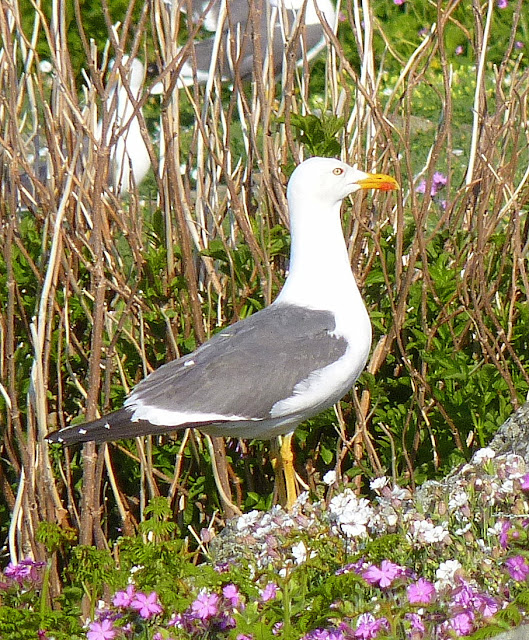Today I am showing you the Gulls that both Stefan Greif and myself came across on Lighthouse Island. The 3 photos below are from Stefan. There were very few Great Black backed Gulls and Common Gulls on the Island and the Kittiwakes were just passing through.
 |
| Great Black backed Gull |
 |
| Common Gull |
 |
| Kittiwakes |
The two largest Gulls that nest on this island are Herring and Lesser Black backed Gulls and this Herring Gull below has just been ringed and it about to be released again.
The European
Herring Gull can be differentiated from the closely related, slightly smaller
Lesser Black-backed Gull by the latter's dark grey (not actually black) back
and upper wing plumage and its yellow legs and feet, as we will see later. As you can see below the Herring Gull is much paler grey and has pale pinkish legs.
Herring Gulls are long lived, with a maximum age of 49 years recorded.
Two to four eggs, usually three, are laid on the ground or cliff ledges in colonies, and are defended vigorously by this large gull. The chicks, when born are in a so called “semi-precocial” state, meaning they are covered in down, eyes open and legs that can stand and walk although they tend to stay near the parents but cannot feed themselves. Juveniles use their beaks to "knock" on the red spot on the beaks of adults to indicate hunger. Parents typically disgorge food for their offspring when they are "knocked".
Herring
Gulls are famous for their chutzpah and it starts early. If the chick thinks that its parents are not
doing a good job of feeding it, and knowing that unless it gets enough food it
will not survive, it makes an extraordinary risky decision. It abandons its parents and slips next door
to another nest hopefully unnoticed and hopefully being accepted by the next
adult Herring Gull. If it does not work,
it will be evicted or killed however if it does work, it could be their
passport for its adult life.
The following 3 shots are from Stefan
Below you see the Herring Gull in the foreground and the
Lesser Black backed Gull behind it.
Now I will show you the Lesser Black Backed Gull below. (SG)
The Lesser Black backed Gull is a large gull that breed on the
Atlantic coasts of Europe and of course I saw them at first hand on Lighthouse
Island at Copeland Islands last weekend.
It is migratory Gull, wintering from the
British Isles south to West Africa. It
is a regular winter visitor to the east coast of North America, probably from
the breeding population in Iceland.
They are slightly smaller than the Herring Gull.
Above is a Lesser Black backed Gull in flight. (SG)
This Lesser Black backed Gull above is having rabbit for lunch! (SG)
 |
| Lesser Black backed chick (SG) |
Lesser Black backed Gulls are typically monogamous and arrive
at nesting colonies from
April. The nest can be anything from a heap of grass or feathers, to a simple,
sparsely-lined scrape.
Up to three eggs are laid, between May and mid-June, and
are incubated by both adults for up to 28 days.
The chicks fledge at 30 to 40 days, after which they join
other immature birds and non-breeding adults in ‘clubs’, spending most of their
time resting and preening. The Lesser Black backed gull becomes sexually mature
at four years old.
When the chicks are young it is VERY difficult to tell the Lesser Black backed from the Herring Gull chicks.
I am leaving you with a video of the Lesser Black backed Gulls and can be viewed either through youtube at
http://youtu.be/bohZCigkVu8 or below
I hope you enjoyed this post today. Tomorrow we will see the Puffins so I hope you will look in again. Thanks for visiting today.




















Again photos are outstanding, the facts are great, funny a little chick would risk going to another nest, that is quite something. I'd read about the red spot on the beak and the chicks, very clever! Todays video is great however it stopped at 1:54 seconds for me twice...
ReplyDeleteHi Lynn I am sorry your video stopped. That is usually due to too slow a broadband. Perhaps you can ttry it adn not to usy a time that people are using the internet. Glad you liked the photos.Stefan's ones are marvellous. Margaret
DeleteWhat amazing shots! And I had no idea that they lived so long. What beautiful creatures. What an amazing Creator!
ReplyDeleteHi Yes it is amazing how long they live. Thanks for comment. Margaret
Deletesuch beautiful birds. and very long-lived! really cute chicks.
ReplyDeleteHi Tex Yes it is amazing how long the guls live for. Thanks for comments. MArgaret
DeleteI like gulls, they have great eyes.
ReplyDeletepeter
HI Peter Well this post suited you then. Gulls all the way.Margaret
DeleteI love seagulls, we have a wide variety here at the Jersey Shore!! Beautiful images, so much detail in these amazing close ups !!
ReplyDeleteHi Debbie Yes it is not often we can getthis close to seagulls, They really are beautiful. Margaret
ReplyDeleteThe chicks are adorable and very interesting about them sneaking into another nest to get more food.
ReplyDeleteHi Mary Yes the chicks are lovely adn very soft when they are in your hand. Thanks for commenet. Margaret
ReplyDelete